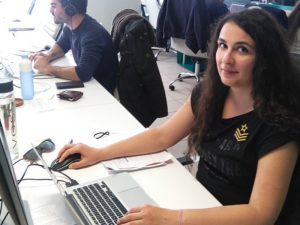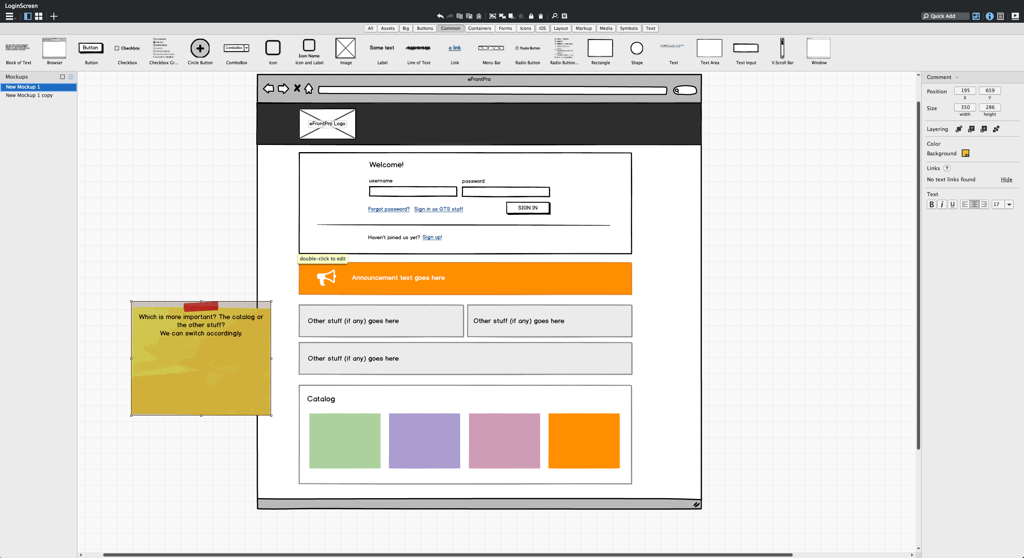The Keys to Satisfaction as a UX Designer
 Sofia Terzidou is a UX designer for the Epignosis R&D team in Athens, Greece. She has been designing "digital things" for 20 years and relies on Balsamiq Mockups for her daily work.
Sofia Terzidou is a UX designer for the Epignosis R&D team in Athens, Greece. She has been designing "digital things" for 20 years and relies on Balsamiq Mockups for her daily work.
We spoke to her about her UX process and the unique challenges of the eLearning industry. She talks about finding satisfaction in her role, which includes: working on products that have a positive impact, finding empathy with your end users, and working with colleagues as one team.
Q&A with Sofia Terzidou
What industry do you work in, and what is your title or job description?
I work in the eLearning industry, as a UI/UX designer. My job includes working on eFrontPro and TalentLMS, maintaining and improving parts of those platforms. Usually I tackle issues such as ensuring the logical flow from one step to the next, optimizing parts of the interface and adding new visuals, as well as designing new features.
What kinds of things are you excited about in your industry?
I like the fact that the products I work on have a very positive impact on those who decide to use them. Our eLearning platforms and tools allow companies to train their people faster, easier and with less cost than traditional methods. It’s also great to be able to hear about the pain points our users might have. That is the best way to lead a product to actual improvement, since you know exactly where to intervene without having to rely on guesswork.
What suggestions do you have for someone looking to succeed in your role or industry?
If you want to work as a designer and be quite successful at it, you need to like problem solving, you’ve got to have a business mindset, you will find that the best way to get educated is self education, and most importantly you have to be able to walk in the shoes of the people who use the products you design. The end users are the people you really work for.
 Sofia uses Balsamiq Mockups 3 for Desktop for her wireframes.
Sofia uses Balsamiq Mockups 3 for Desktop for her wireframes.
A perfect opportunity to do all that, is to work as a designer in the eLearning industry. It is a field that provides many chances to sharpen your skills in many design areas. You get immediate feedback from users, you get to work with other designers and developers and sooner or later you will develop the appropriate mindset that will allow you to balance business and user needs.
What tools or techniques do you use to connect with customers to get feedback?
We have two major eLearning platforms and, as expected, we get a lot of feedback from our clients, especially concerning improvements and new feature requests. We gather this kind of feedback mainly through our famous support center and feed it back into the products. We also use Evalyzer and Inspectlet, we run frequent usability tests and we will soon conduct an NPS survey!
Where does UX fit into the process at your company? Have you ever had to "fight" to prioritize experience over features? If so, what strategies have been effective for you?
Ah, the never-ending war between Experience and Development. Thankfully, we act as a product development team and not as two (or more) separate teams. Since all team members understand concepts such as decision paralysis, it's quite easy to decide which features will make it to the design room. Still, disagreements cannot always be avoided.
The best strategy to resolve conflict and avoid potential doom is to listen, ask questions and try to understand what the other party really wants to say. It's surprising that sometimes we're on the same side and we are trying to say the same thing but we don't even know it. Good communication is key to everything!
Why and how do you use Balsamiq Mockups?
I’m a huge pen and paper fan. Still, when you work in big teams or remotely even, sending stacks of papers via snail mail is not very practical. Joking aside, in my opinion Balsamiq Mockups is the best software that can act as efficiently as pen & paper. It’s fast, very easy to learn, it has many tools, people can collaborate on it and best of all it’s simple and determined to do the job it was built to do.
 One of Sofia's wireframes for a notification design.
One of Sofia's wireframes for a notification design.
That’s low-fi wireframing, which is the best way to keep you focused on solving a problem rather than getting distracted with visual design and general eye candy. That’s more or less how I use it anyway. Every new feature that needs to be designed, no matter how big or small, finds its path through a Balsamiq Mockup which is often shared to the team as a pdf document. I really like that feature.
Do you have any Balsamiq Mockups tips or tricks that you'd like to share?
- Use Symbols! Very often you will find yourself in the position of having to change a thing common to many different mockups. Doing that without having used symbols, can make your life pretty miserable.
- Use Comments! Yes, comments. That little yellow sticky thing with the scotch tape and everything, is a lovely tool of communication, that can get you out of long skype calls, even longer meetings and potential unnecessary conflict.
- Use Skins and Fonts! While I enjoy wireframing in the default settings as they remind me of my beloved pen & paper, sometimes it's necessary to show a more polished look to a stakeholder. You can achieve that by changing the skin to 'wireframe' and by selecting a font other than Balsamiq Sans. Ditching the graph paper, will help too 🙂
Where do you look for inspiration? Are there some websites or designers you follow?
Inspiration lies everywhere. The design of everyday products, a good book and websites such as designtaxi.com, medium.com, abduzeedo.com and Smashing Magazine are great to learn and try out new things and of course get inspired. Twitter is a good place to follow great designers and developers and get some insight on how they think. Last but not least, a good ol' bicycle ride is always refreshing! 🙂
Thank you, Sofia!
Do you have a story to share about the awesome things you do with Balsamiq? Send an email to champions@balsamiq.com with your stories or blog posts!


